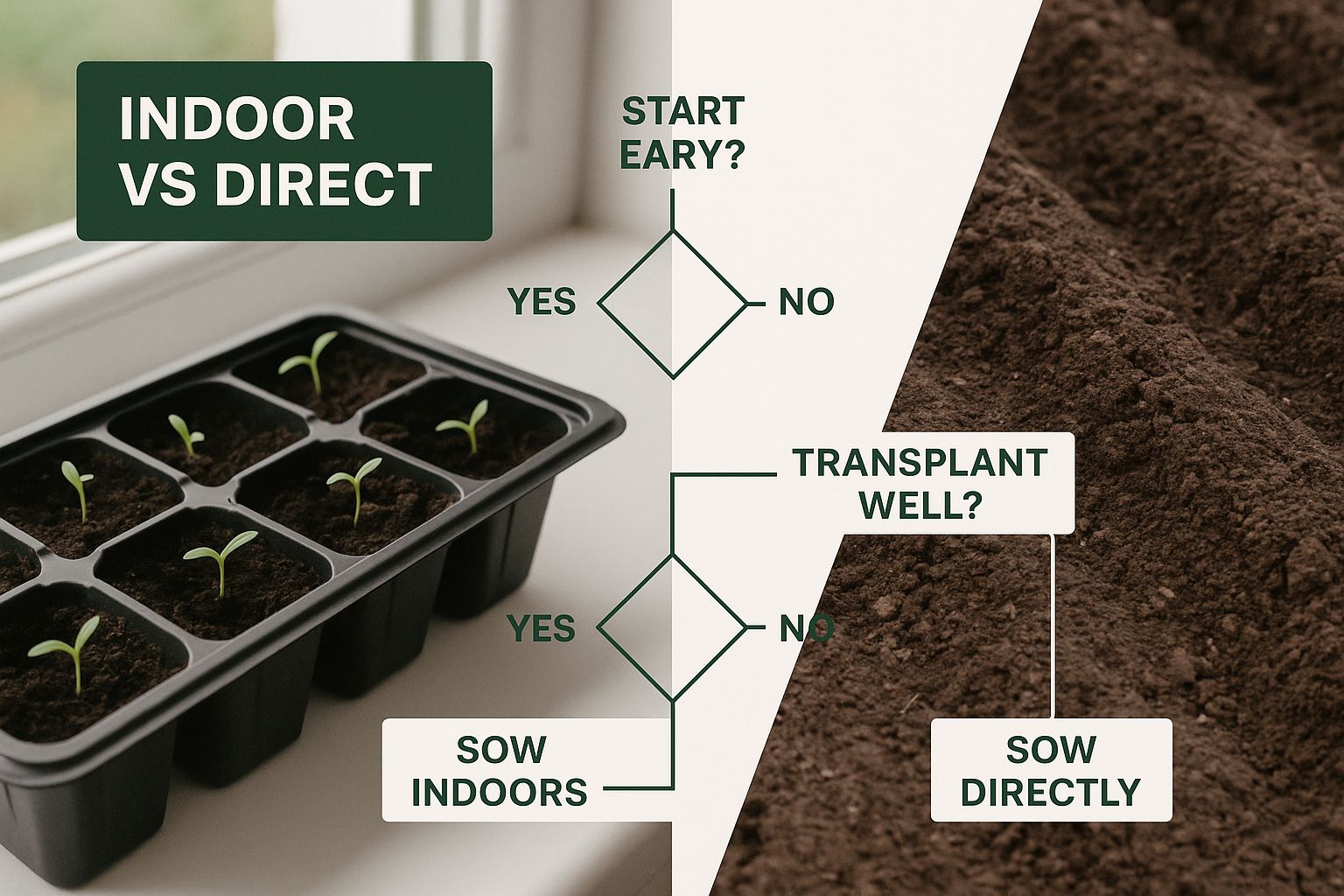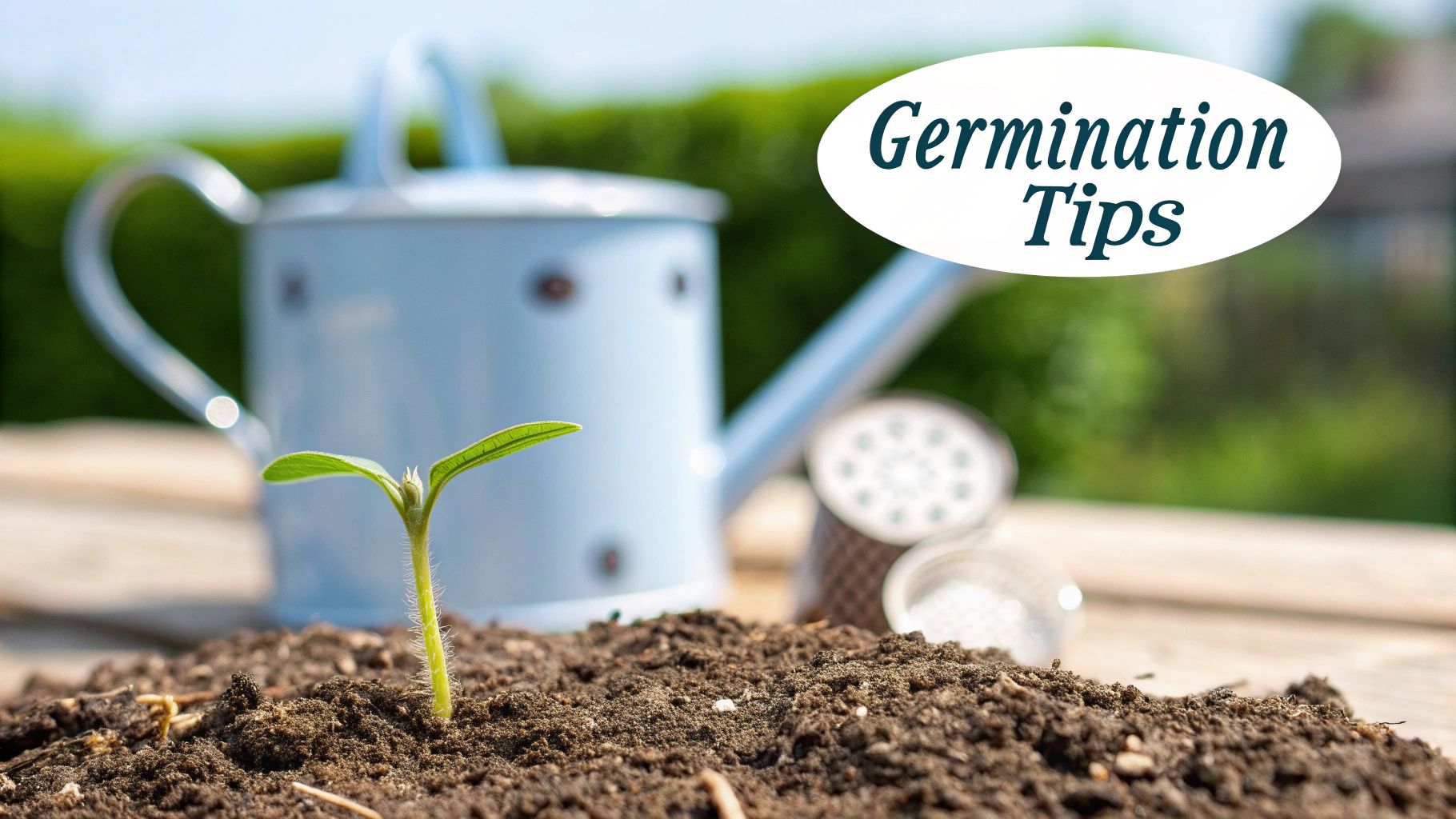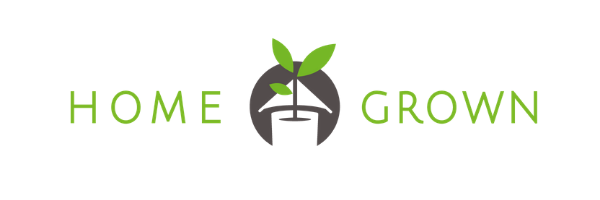
Figuring out the right time to plant your vegetable seeds is less about a specific date on the calendar and more about learning to read your garden's unique signals. The two most important clues you need to pay attention to are your local frost dates and, even more importantly, the soil temperature. These are the true gatekeepers to a successful planting season.
Finding Your Perfect Planting Window
One of the biggest mistakes I see new gardeners make is getting a little too eager. A few warm, sunny days in early spring feel promising, but rushing to get seeds in the ground can often lead to disappointment. Real, lasting success in the garden comes from patience and observation.
When you understand the 'why' behind planting times, you can adapt to whatever wild weather a season throws at you. It gives every single seed the best possible shot at life, and honestly, it's what separates a thriving, productive garden from a frustrating patch of dirt.
At its heart, timing your vegetable planting boils down to two main groups: cool-season crops and warm-season crops. Each group has completely different requirements, and they will absolutely fail if you plant them at the wrong time.
Cool-Season vs. Warm-Season Crops
Cool-season vegetables are the tough guys of the garden. Think of things like lettuce, spinach, peas, and kale. These plants don't just put up with the chill of early spring and late fall—they actually prefer it. Their seeds are happy to germinate in cooler soil, and many, like kale and carrots, even get a little sweeter after a light frost. These are the first seeds you'll be planting in the spring and the last ones you'll sow for a fall or winter harvest.
Warm-season vegetables, on the other hand, are total sun-worshippers. This is where your classic summer favorites come in: tomatoes, peppers, cucumbers, and squash. They are incredibly sensitive to the cold and a single frost will wipe them out. Just as crucial, their seeds absolutely require warm soil to even think about sprouting. Planting them too early, when the ground is still cold and damp, is a surefire recipe for rotten seeds and a whole lot of wasted effort.
Gardener's Tip: Don't guess—get a soil thermometer. A simple one from the garden center or even a digital cooking thermometer works perfectly. Stick it about 4-6 inches deep in your garden bed for a few days in a row to get an accurate reading. This gives you a much better picture of what's happening underground than the air temperature alone.
The specific climate in your region dictates everything. For example, here in my temperate garden, spring planting for many crops can start once the soil consistently hits about 50°F (10°C). But for gardeners in colder climates with much shorter growing seasons, they have to wait until mid or even late spring to be sure the threat of frost has truly passed. For a broader look at global vegetable trends, you can find some fascinating insights from the global vegetable sector on Rabobank.com.
To make all this planning a bit easier, I've put together a quick reference table. It breaks down some popular vegetables by their preferred season and the minimum soil temperature they need to sprout. Think of it as your cheat sheet for getting your timing just right.
Vegetable Planting Cheat Sheet by Season and Temperature
This table is a great starting point for figuring out when to get your seeds in the ground. Remember that these are minimum temperatures—waiting for the soil to be a few degrees warmer is often even better for quick, strong germination.
| Vegetable | Planting Season | Minimum Soil Temperature for Germination | Notes |
|---|---|---|---|
| Lettuce | Cool | 35°F (2°C) | Ideal germination is much warmer, around 75°F. |
| Spinach | Cool | 35°F (2°C) | Bolts (goes to seed) quickly in hot weather. |
| Peas | Cool | 40°F (4°C) | Plant as soon as the soil can be worked in spring. |
| Carrots | Cool | 40°F (4°C) | Germination can be slow; keep soil consistently moist. |
| Radishes | Cool | 45°F (7°C) | Very fast-growing; great for succession planting. |
| Tomatoes | Warm | 60°F (16°C) | Don't rush these! Cold soil stunts growth. |
| Peppers | Warm | 65°F (18°C) | Need consistent warmth to thrive. |
| Cucumbers | Warm | 60°F (16°C) | Plant after all danger of frost has passed. |
| Corn | Warm | 55°F (13°C) | Plant in blocks for good pollination. |
| Beans | Warm | 60°F (16°C) | Quick to germinate in warm soil. |
| Squash | Warm | 60°F (16°C) | Includes zucchini, pumpkins, and other varieties. |
Use this guide as your foundation, but always pair it with real-world observation of your own garden's conditions. With a little practice, you'll get a feel for the rhythm of the seasons and know exactly when to plant for a fantastic, bountiful harvest.
Cracking the Code of Your Local Climate & Frost Dates

If I could give a new gardener just one piece of critical data, it wouldn't be about fertilizer or soil. It would be two simple dates: your area’s average last spring frost and its average first fall frost.
These two dates are the bookends of your entire growing season. Everything else you plan—from starting tiny seeds on a windowsill to timing that final autumn harvest—hinges on knowing them. Get these right, and you've laid the foundation for a successful garden.
Finding Your Frost Dates
So, where do you find this magic information? While your USDA Hardiness Zone is useful for selecting perennials that can survive your winter, it won't tell you your frost dates. Those can change dramatically even within the same zone.
Thankfully, you don't have to guess. Here’s where I always look for reliable data:
- Agricultural Extension Offices: Your local university extension service is an absolute goldmine. They provide charts and advice tailored specifically to your county or region.
- National Weather Services: Government sites, like the National Oceanic and Atmospheric Administration (NOAA) in the U.S., have robust climate data centers, often searchable by zip code.
Once you have your last spring frost date, you can treat it like a finish line. Now, we just need to work backward to build out your entire spring planting calendar.
Putting Your Frost Dates to Work
This is where the planning really comes to life. Your frost dates aren't just trivia; they are the key that unlocks the instructions on every seed packet you own.
Let's walk through a real-world example. Say your average last spring frost is May 15th. You're holding a packet of tomato seeds, and the instructions say to start them indoors 6-8 weeks before the last frost. All you have to do is count back 8 weeks from May 15th, which puts you right in the middle of March. That’s your window to get those tomato seeds sown indoors.
It works the other way for direct sowing, too. If your beet seeds can be planted 2-3 weeks before the last frost, you now know you can get them in the ground around the end of April, giving those cool-season crops a much-needed head start.
My Core Philosophy: Treat your last spring frost date as the anchor for your entire spring plan. Count backward for indoor starts and forward to figure out when it's safe to transplant or direct-sow outside.
This simple bit of garden math turns the overwhelming question of "when to plant?" into a straightforward, logical process.
Look Closer: Understanding Your Garden's Microclimates
While regional frost dates give you a fantastic baseline, your own yard is more complex than you might think. It’s full of little pockets called microclimates, where conditions are just a bit different from the surrounding area. Learning to spot these is a gardener’s secret weapon.
For example, a garden bed right up against a south-facing brick wall will soak up and radiate heat. This spot will warm up much faster in the spring and stay frost-free a little longer in the fall, potentially buying you an extra week or two of growing time.
On the other hand, a low spot in your yard can become a frost pocket. Cold air is dense and heavy, so it sinks and pools in these depressions. I learned this the hard way one year when an early frost zapped the zucchini I'd planted in a dip, while the plants on slightly higher ground were completely untouched.
Keep an eye out for these common microclimates in your own space:
- Warm Spots: Near your home's foundation, along south-facing walls, or next to dark-colored pavement.
- Cool Spots: In low-lying areas, on north-facing slopes, or in spots that get a lot of shade.
- Wind Tunnels: In open, exposed areas or around the corners of buildings that can dry out soil and batter plants.
- Sheltered Zones: Spots protected from the elements by a fence, a hedge, or other buildings.
Paying attention to these subtle variations lets you be more strategic. You can put your tough, cool-season crops in a more exposed area and save that premium, warm microclimate for your most tender, heat-loving plants. This is how you go from just following the rules to truly mastering your garden's unique rhythm.
Giving Your Plants a Head Start Indoors
If you're gardening somewhere with a short growing season, starting seeds inside isn't just a neat trick—it's often the secret to a successful harvest. This one technique can give you a crucial 4 to 8 week jump on the season. That head start makes all the difference for slow-growing crops that crave the summer heat.
Think of your last frost date as the starting pistol for the outdoor garden race. By sowing seeds indoors ahead of time, you're bringing plants to the starting line that are already warmed up and ready to go. This is especially vital for vegetables that need a long, warm season to really hit their stride, like tomatoes, peppers, and eggplants.
Without an indoor start, these plants might just be starting to set fruit as the first cool hints of fall creep in, which can seriously limit your harvest. The real goal is to have healthy, robust seedlings ready to pop into the garden the moment the weather is finally on your side.
The Indoor Advantage: Timing Is Everything
The key to figuring out when to plant your vegetable seeds indoors is all about working backward from your area's average last spring frost date. It's a bit of a balancing act. Sow them too early, and you’ll be wrestling with overgrown, "leggy" seedlings that are weak and stressed out. Start them too late, and you completely lose the advantage you were aiming for.
Most seed packets will give you specific recommendations, but a solid rule of thumb is to sow seeds about 6 to 8 weeks before your last frost. This is the sweet spot for the vast majority of popular garden vegetables.
Let's walk through a real-world example. My last frost date here is typically around May 20th. I just count back eight weeks from that date, which lands me squarely on March 25th. That becomes my target for getting my tomato and pepper seeds sown indoors.
Key Insight: The date you put the seed in the soil is just the beginning. The actual goal is to raise a stocky, healthy seedling that's the perfect size for transplanting—not a lanky, overgrown plant that will have a hard time adjusting to the great outdoors.
Gearing Up for Indoor Success
You don't need a fancy greenhouse to get this right, but a few pieces of gear are non-negotiable if you want to grow strong, healthy seedlings. Getting your setup right from the start helps you sidestep the common problems that can kill your plants before they even see the garden.
From my experience, this is the essential gear that makes the biggest impact:
- Seed Starting Mix: Please, do not use soil from your garden. You need a sterile, light, and fluffy seed-starting mix. This is your best defense against a fungal disease called "damping-off," which rots tiny seedlings right at the soil line.
- Containers with Drainage: You've got options here. Specialized seed trays, peat pots, or even cleaned-out yogurt cups with holes poked in the bottom all work. The critical feature is that excess water has a way to escape.
- A Reliable Light Source: A sunny windowsill is almost never enough light. This is the most common mistake I see new gardeners make, and it results in pale, weak seedlings stretching desperately toward the window. A simple fluorescent shop light or a dedicated LED grow light hung just a few inches above your plants is absolutely essential.
For a deeper dive into the process, our comprehensive guide walks you through everything. You can learn more about when to start seeds indoors and find more tips to give your seedlings the best possible start in life.
The Final Step: Hardening Off
Once your seedlings are looking great and the weather outside has finally settled, you can't just move them from their cozy indoor home straight into the garden. The shock from direct sun, wind, and temperature swings would be too much for them. This is where the crucial process of hardening off comes into play.
This simple technique gradually gets your tender plants used to the tougher conditions of the outdoors over 7 to 14 days. It's a step you absolutely cannot skip if you want your plants to survive the move and truly thrive.
Here's a sample schedule I follow to manage this important transition:
- Days 1-3: I'll set the seedlings out in a shady, protected spot for just an hour or two, then bring them back inside.
- Days 4-6: I start increasing their outdoor time to 3-4 hours, slowly introducing them to a little bit of gentle morning sun.
- Days 7-10: Now they can stay out for most of the day. I'll let them get more direct sunlight and feel a bit of a breeze.
- Days 11-14: If the overnight temperatures are mild, I'll let them stay outside all night.
After this gradual introduction, your plants will be tough, resilient, and ready for their new home in the garden. This careful transition protects all the time and effort you've invested and sets the stage for a fantastic, productive season.
Getting Your Hands Dirty: The Art of Direct Sowing
While getting a head start by sowing seeds indoors is a great technique for certain plants, it’s not always the best approach. In fact, for some vegetables, it's a terrible idea. Many crops, especially root vegetables like carrots, radishes, and beets, absolutely hate having their roots disturbed. For these guys, direct sowing—planting seeds straight into the garden soil—is the only way to go.
The secret to success with direct sowing boils down to one critical factor: soil temperature. Don't let the air temperature fool you. A string of warm, sunny days in spring might have you itching to plant, but if the ground is still cold, your seeds will just sit there and rot. The soil is where the magic happens, making its warmth the only reliable indicator for planting time.
This infographic lays out the core decision-making process beautifully, helping you choose between starting seeds inside or sowing them directly in your garden.

As the graphic shows, the right method really depends on the plant's personality and the length of your local growing season. There’s no single answer that fits every vegetable in your garden.
How to Really Know When It's Time
Figuring out your soil's temperature is surprisingly simple and doesn't require any fancy equipment. A basic soil thermometer, which you can grab from any garden center for less than ten bucks, is all you need. Honestly, a digital meat thermometer from your kitchen drawer works just as well in a pinch.
For a good reading, stick the thermometer probe about 4-6 inches deep into the soil right where you plan to plant. I find it’s best to check the temperature around midday for a few days in a row and take an average. This gives you a true sense of the conditions your seeds will actually face.
A Tip from My Garden: I always check the temperature in a few different spots. The soil in my sunny, raised bed is often several degrees warmer than a shadier patch of ground. Knowing this lets me sneak my hardiest cool-season crops into the warmer microclimates a bit earlier.
Matching Seeds to Their Happy Place
Different seeds are picky about temperature. Tossing a warm-weather seed into cold soil is a surefire way to get zero results. On the flip side, some cool-season crops won't even bother sprouting if the soil gets too warm. Knowing these preferences is the key to germination.
Here’s a quick guide to the soil temperatures your direct-sow vegetables are waiting for:
- 40°F (4°C) & Up: This is the green light for your toughest cool-weather friends. Think peas, lettuce, spinach, and kale. A little chill doesn't bother them one bit.
- 50°F (10°C) & Up: The soil is warming up nicely. Now you can get more root veggies in the ground, like onions, turnips, and Swiss chard.
- 60°F (16°C) & Up: This is a big milestone. The soil is officially warm enough for corn, beans, carrots, and beets. It’s also generally a safe time to transplant those broccoli and cabbage seedlings you’ve been hardening off.
- 70°F (21°C) & Up: Welcome to the heat-lover's paradise! This is the perfect temperature for sowing squash, melons, and cucumbers.
To help you visualize this decision, let's look at a quick comparison. Deciding whether to start seeds indoors or sow them directly can be tricky, but it usually comes down to the plant's root system and how much time it needs to mature.
Indoor Start vs. Direct Sow Decision Guide
| Vegetable Type | Recommended Method | Reasoning | Ideal Timing |
|---|---|---|---|
| Tomatoes, Peppers | Indoor Start | These have long growing seasons and need a head start, especially in cooler climates. | Start indoors 6-8 weeks before last frost. |
| Carrots, Radishes | Direct Sow | Their taproots are extremely sensitive and do not transplant well. | Sow as soon as soil reaches 40-60°F (4-16°C). |
| Lettuce, Kale | Both | Can be direct sown for a continuous harvest or started indoors for an earlier crop. | Sow directly in early spring/fall or start indoors 4 weeks before last frost. |
| Beans, Peas | Direct Sow | They grow quickly and dislike root disturbance. | Sow directly once soil reaches 60°F (16°C). |
| Cucumbers, Squash | Both | Can be direct sown in warm soil or started indoors 2-4 weeks before last frost to get an earlier harvest. Be very gentle when transplanting. | Sow directly when soil is 70°F (21°C). |
Ultimately, choosing the right method comes down to understanding the specific needs of each vegetable. When in doubt, always go with the method that protects the plant's delicate root system.
Planting for a Bountiful Harvest
Once your soil temperature gives you the go-ahead, a little technique goes a long way. Always check your seed packet for two crucial details: sowing depth and spacing. A good rule of thumb is to plant a seed about twice as deep as its width. Tiny carrot seeds barely need a dusting of soil, while a big bean seed can be planted an inch deep.
Proper spacing is just as important. It prevents your plants from getting crowded and having to fight for sunlight, water, and nutrients, which always leads to a weaker, smaller harvest. For a deeper dive into getting this right, our guide on 10 tips for successful sowing and germination can help you sidestep common mistakes. By combining perfect timing with proper technique, you’re setting your garden up for a truly productive season.
Timing Your Fall and Winter Harvest
Just because the peak summer heat has arrived doesn't mean your gardening year is winding down. In fact, for those in the know, this is the perfect time to start planning your second act. With a bit of foresight, you can use the approaching autumn to your advantage and keep a steady supply of fresh vegetables coming well into the cooler months.
The whole strategy for a successful fall garden revolves around working backward. You need one critical piece of information: your area's average first fall frost date. Once you have that, you can use the "days to maturity" listed on your seed packets to map out the final planting window for all sorts of fantastic cool-season crops.
This method, often called succession planting, is your ticket to following up a summer harvest with a fresh round of vegetables that actually prefer the crisp air of autumn.
Counting Backwards from the First Fall Frost
Let's walk through a real-world example. Say your first fall frost usually hits around October 15th. You've got a packet of carrot seeds that take 70 days to mature. To figure out your last possible planting date, you'd just count back 70 days from October 15th, which puts you around August 6th.
But hold on, there's a little trick to it. As the days get shorter and the temperatures drop in the fall, plant growth naturally slows down. To compensate for this, I always add a "fall factor" of about 14 days to the maturity time. So, for those 70-day carrots, I'd actually plan for them to take closer to 84 days. That means getting them in the ground by late July is a much safer bet.
Pro Tip: The formula is your best friend here: (Days to Maturity + Fall Factor) - First Fall Frost Date = Your Last Planting Date. This simple calculation is the key to unlocking a bountiful late-season harvest.
Some Vegetables Get Sweeter with a Kiss of Frost
Here's one of the best-kept secrets of fall gardening: a light frost isn't something to fear. For some crops, it's actually a flavor booster. When temperatures dip, certain vegetables convert their internal starches into sugars as a natural antifreeze. The result? They become noticeably sweeter.
You'll discover an incredible depth of flavor in these frost-tolerant champions:
- Kale: Loses a lot of its bitterness and becomes wonderfully tender after a frost.
- Brussels Sprouts: They're famous for it! They really develop their best nutty-sweet flavor after a cold snap.
- Carrots & Parsnips: The sweetness in these roots intensifies like you wouldn't believe.
- Spinach: A light frost can make the leaves taste crisper and sweeter.
To really dive deep into what you can grow, check out all the amazing vegetables to plant for the fall season in our detailed guide. It's packed with more crop ideas and specific timing advice.
Stretch Your Season with Simple Protections
Even with perfect timing, the cold will eventually settle in. But you can push back the end of your season significantly by using a few simple tools to shield your plants. Think of these as mini-greenhouses that trap solar heat during the day and protect your crops from frost overnight.
Here are a few of my go-to season extenders:
- Row Covers: This is as simple as it gets. Lightweight fabric draped over some hoops creates a low tunnel. This alone can raise the temperature underneath by several degrees and easily add weeks to your harvest window.
- Cold Frames: Basically a bottomless box with a clear, sloped lid, a cold frame acts like a miniature unheated greenhouse. They are fantastic for hardening off spring seedlings and can keep hardy greens like lettuce and spinach going all winter long in many climates.
- Cloches: These are just individual plant covers. While you can buy traditional glass bell jars, you can make your own by cutting the bottom off a plastic milk jug and placing it over a single plant. Easy and effective.
Using these techniques isn't just about gardening in the fall; it's about actively managing your garden's microclimate. This hands-on approach will let you enjoy fresh, homegrown produce long after most gardens have been put to bed, turning a three-season hobby into a year-round passion.
Common Planting Time Questions Answered

Even with the best guides, some questions always seem to surface the moment you’re standing there with a seed packet in your hand. Knowing exactly when to plant can feel like a surprisingly high-stakes decision. Let’s walk through some of the most common uncertainties so you can get your seeds in the ground with confidence.
Can I Plant Seeds Early If We Have a Warm Spring?
It’s the ultimate temptation for any gardener itching to get started. The sun is out, it feels like spring has sprung weeks ahead of schedule, and you're wondering... should I go for it?
As tempting as it is, planting based on a fluke warm spell is a huge gamble. A late frost can, and often does, sneak back in and wipe out your tender new seedlings in a single night. But the air temperature is only half the story. The real key is the soil temperature.
Even when the air feels warm, the ground itself takes much longer to heat up. Most seeds, especially your summer favorites like beans, corn, and squash, will just sit there in cold, damp soil. At best, you'll get poor germination; at worst, they'll rot before they even have a chance to sprout. I learned this the hard way one year, losing an entire crop of peas because I jumped the gun. The soil just wasn't ready.
A Gardener's Rule of Thumb: Trust your soil thermometer over a temporary warm spell. Your region's average last frost date is a far more reliable guide. If you're determined to get a head start, use cold frames or row covers to create a protected microclimate for your plants.
What Happens If I Plant My Seeds Too Late?
On the flip side, waiting too long brings its own set of challenges. The specific consequences really depend on what you're planting and when.
For warm-season crops like tomatoes and peppers, a late start means they won't have a long enough growing season. They'll run out of time to mature and produce a full harvest before the first autumn frost shuts things down. You might get a few tomatoes, but you'll miss out on the plant's true potential.
For cool-season crops like spinach or lettuce, planting them too late in the spring means they'll be trying to grow during the peak summer heat. This stress causes them to "bolt"—a survival mechanism where they abandon leaf production and shoot up a flower stalk. Once that happens, the leaves turn bitter and tough.
And if you're planning a fall garden, planting too late means your crops won't be big enough to handle the colder weather and shorter days of late autumn, leading to a stunted or completely failed harvest.
How Do I Use the "Days to Maturity" on a Seed Packet?
That "days to maturity" number is one of the most useful bits of information on a seed packet. It's the estimated time from planting to your first harvest. The trick is knowing when to start the clock.
- For seeds started indoors: The countdown begins the day you transplant the seedling into the garden—not the day you sowed the seed in its pot.
- For direct-sown seeds: The countdown starts once the seedling pokes through the soil.
You can use this number to work backward and schedule everything. Say you have a carrot variety that takes 70 days to mature, and your first fall frost usually hits around October 15th. You'll need to sow those seeds by early August at the latest to ensure they're ready for harvest before the ground freezes. For fall crops, it's also smart to add a "fall factor" of about two weeks to account for the slowing growth as the days get shorter.
Does My USDA Hardiness Zone Tell Me When to Plant?
This is a really common point of confusion for new gardeners. The short answer is no, your USDA Hardiness Zone doesn't tell you when to plant your annual vegetables.
Your zone number is all about the average coldest winter temperature your area experiences. It’s fantastic for choosing perennials, shrubs, and trees that can survive the winter and return each year.
But it tells you nothing about your frost dates. Two towns in the exact same hardiness zone can have completely different last spring frost dates because of things like elevation, latitude, or how close they are to a large body of water.
So, use your zone to pick the right varieties of plants, but find your specific, local frost dates to actually build your vegetable planting calendar. They're two different—but equally important—pieces of the gardening puzzle.
Ready to put this knowledge into practice and start your own garden? At Homegrown Garden, we have everything you need, from a wide selection of heirloom seeds to starter kits and expert guides to help you succeed.
Find the perfect seeds for your garden at Homegrown Garden today!



